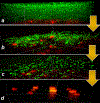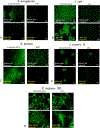Optically Responsive, Smart Anti-Bacterial Coatings via the Photofluidization of Azobenzenes
- PMID: 30605328
- PMCID: PMC6552654
- DOI: 10.1021/acsami.8b21058
Optically Responsive, Smart Anti-Bacterial Coatings via the Photofluidization of Azobenzenes
Abstract
Antibacterial strategies sans antibiotic drugs have recently garnered much interest as a mechanism by which to inhibit biofilm formation and growth on surfaces due to the rise of antibiotic-resistant bacteria. Based on the photofluidization of azobenzenes, we demonstrate for the first time the ability achieve up to a 4 log reduction in bacterial biofilms by opto-mechanically activating the disruption and dispersion of biofilms. This unique strategy with which to enable biofilm removal offers a novel paradigm with which to combat antibiotic resistance.
Keywords: antibacterial and antifouling strategies; antibacterial coatings; azobenzenes; optically responsive materials; photofluidization; photoresponsive polymers; smart materials.
Figures




Similar articles
-
A novel acid-responsive polymer coating with antibacterial and antifouling properties for the prevention of biofilm-associated infections.Colloids Surf B Biointerfaces. 2024 Jul;239:113939. doi: 10.1016/j.colsurfb.2024.113939. Epub 2024 May 2. Colloids Surf B Biointerfaces. 2024. PMID: 38744077
-
Layer-by-layer self-assembly of minocycline-loaded chitosan/alginate multilayer on titanium substrates to inhibit biofilm formation.J Dent. 2014 Nov;42(11):1464-72. doi: 10.1016/j.jdent.2014.06.003. Epub 2014 Jun 12. J Dent. 2014. PMID: 24930872
-
Bacterial adherence and biofilm formation on medical implants: a review.Proc Inst Mech Eng H. 2014 Oct;228(10):1083-99. doi: 10.1177/0954411914556137. Proc Inst Mech Eng H. 2014. PMID: 25406229 Review.
-
Bacterial crowd control with iron.Chem Biol. 2005 Jul;12(7):721-3. doi: 10.1016/j.chembiol.2005.07.001. Chem Biol. 2005. PMID: 16039519
-
Smart self-defensive coatings with bacteria-triggered antimicrobial response for medical devices.Biomater Sci. 2024 Oct 22;12(21):5433-5449. doi: 10.1039/d4bm00936c. Biomater Sci. 2024. PMID: 39320148 Review.
Cited by
-
Selective Inhibition of Streptococci Biofilm Growth via a Hydroxylated Azobenzene Coating.Adv Mater Interfaces. 2020 Aug 6;7(15):1902149. doi: 10.1002/admi.201902149. Epub 2020 Jun 8. Adv Mater Interfaces. 2020. PMID: 33575161 Free PMC article.
-
Azobenzene as Antimicrobial Molecules.Molecules. 2022 Sep 1;27(17):5643. doi: 10.3390/molecules27175643. Molecules. 2022. PMID: 36080413 Free PMC article. Review.
-
Current approaches to produce durable biomaterials: Trends in polymeric materials for restorative dentistry applications.Dent Mater. 2024 Dec;40(12):2122-2134. doi: 10.1016/j.dental.2024.10.004. Epub 2024 Oct 18. Dent Mater. 2024. PMID: 39424526 Review.
-
Acrylated Hydroxyazobenzene Copolymers in Composite-Resin Matrix Inhibits Streptococcus mutans Biofilms In Vitro.Pediatr Dent. 2021 Nov 15;43(6):484-491. Pediatr Dent. 2021. PMID: 34937621 Free PMC article.
-
Rate-based approach for controlling the mechanical properties of 'thiol-ene' hydrogels formed with visible light.Polym Chem. 2019 Aug 28;10(32):4428-4440. doi: 10.1039/C9PY00447E. Epub 2019 Jul 8. Polym Chem. 2019. PMID: 32405326 Free PMC article.
References
-
- Bao Q; Nishimura N; Kamata H; Furue K; Ono Y; Hosomi M; Terada A Antibacterial and Anti-Biofilm Efficacy of Fluoropolymer Coating by a 2,3,5,6-Tetrafluoro-p-Phenylenedimethanol Structure. Colloids Surf. B 2017, 151, 363–371. - PubMed
-
- Gilbert P; Allison DG; McBain AJ Biofilms in Vitro and in Vivo: Do Singular Mechanisms Imply Cross-Resistance? J. Appl. Microbiol. 2002, 92 (s1), 98S–110S. - PubMed
-
- O’Neill J Tackling Drug-Resistant Infections Globally: Final Report and Recommendations. Rev. Antimicrob. Resist. 2016, May, 1–75.
MeSH terms
Substances
Grants and funding
LinkOut - more resources
Full Text Sources
Other Literature Sources

